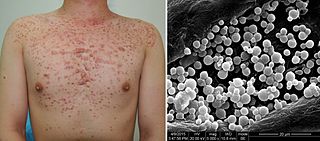Related Research Articles

Tinea cruris, also known as jock itch, is a common type of contagious, superficial fungal infection of the groin and buttocks region, which occurs predominantly but not exclusively in men and in hot-humid climates.

A sebaceous gland or oil gland is a microscopic exocrine gland in the skin that opens into a hair follicle to secrete an oily or waxy matter, called sebum, which lubricates the hair and skin of mammals. In humans, sebaceous glands occur in the greatest number on the face and scalp, but also on all parts of the skin except the palms of the hands and soles of the feet. In the eyelids, meibomian glands, also called tarsal glands, are a type of sebaceous gland that secrete a special type of sebum into tears. Surrounding the female nipple, areolar glands are specialized sebaceous glands for lubricating the nipple. Fordyce spots are benign, visible, sebaceous glands found usually on the lips, gums and inner cheeks, and genitals.

A dermatofibroma, or benign fibrous histiocytomas, is a benign nodule in the skin, typically on the legs, elbows or chest of an adult. It is usually painless.

Onychomycosis, also known as tinea unguium, is a fungal infection of the nail. Symptoms may include white or yellow nail discoloration, thickening of the nail, and separation of the nail from the nail bed. Fingernails may be affected, but it is more common for toenails. Complications may include cellulitis of the lower leg. A number of different types of fungus can cause onychomycosis, including dermatophytes and Fusarium. Risk factors include athlete's foot, other nail diseases, exposure to someone with the condition, peripheral vascular disease, and poor immune function. The diagnosis is generally suspected based on the appearance and confirmed by laboratory testing.

Scrofuloderma is a skin condition caused by tuberculous involvement of the skin by direct extension, usually from underlying tuberculous lymphadenitis.
Diabetic dermopathy is a type of skin lesion usually seen in people with diabetes mellitus. It is characterized by dull-red papules that progress to well-circumscribed, small, round, atrophic hyperpigmented skin lesions usually on the shins. It is the most common of several diabetic skin conditions, being found in up to 30% of diabetics. Similar lesions can occasionally be found in non-diabetics usually following trauma or injury to the area; however, more than 4 lesions strongly suggests diabetes.

Flucloxacillin, also known as floxacillin, is an antibiotic used to treat skin infections, external ear infections, infections of leg ulcers, diabetic foot infections, and infection of bone. It may be used together with other medications to treat pneumonia, and endocarditis. It may also be used prior to surgery to prevent Staphylococcus infections. It is not effective against methicillin-resistant Staphylococcus aureus (MRSA). It is taken by mouth or given by injection into a vein or muscle.

Necrobiosis lipoidica is a rare, chronic skin condition predominantly associated with diabetes mellitus. It can also occur in individuals with rheumatoid arthritis or without any underlying conditions (idiopathic). It is characterized by hardened, raised areas of the skin, often appearing on the shins, with a yellowish center and a surrounding dark pink area. The lesions are generally asymptomatic but can become tender and ulcerate when injured.

Periorbital dermatitis is a skin condition, a variant of perioral dermatitis, occurring on the lower eyelids and skin adjacent to the upper and lower eyelids.
Keratosis pilaris atrophicans faciei begins in infancy as follicular papules with perifollicular erythema. Initially, the lesions are restricted to the lateral eyebrows, but with time spread to involve the cheeks and forehead, and may also be associated with keratosis pilaris on the extremities and buttocks.
Primary inoculation tuberculosis is a skin condition that develops at the site of inoculation of tubercle bacilli into a tuberculosis-free individual.
Papulonecrotic tuberculid is usually an asymptomatic, chronic skin disorder, presenting in successive crops, skin lesions symmetrically distributed on the extensor extremities.

Malassezia folliculitis or pityrosporum folliculitis, is a skin condition caused by infection by Malassezia yeast.
Cutaneous actinomycosis is a chronic disease that affects the deep subcutaneous tissue of the skin. Caused by an anaerobic, Gram-positive, filamentous type of bacteria in the genus Actinomyces, invasion of the soft tissue leads to the formation of abnormal channels leading to the skin surface that discharge pale yellow sulfur granules.

Cutaneous lymphoid hyperplasia refers to a groups of benign cutaneous disorders characterized by collections of lymphocytes, macrophages, and dendritic cells in the skin. Conditions included in this groups are:
Waxy skin is a cutaneous condition observed in roughly 50% of diabetic patients with longstanding disease.
Diabetic dermadromes constitute a group of cutaneous conditions commonly seen in people with diabetes with longstanding disease. Conditions included in this group are:
Pyostomatitis vegetans is an inflammatory stomatitis and most often seen in association with inflammatory bowel disease, namely ulcerative colitis and Crohn's disease. Uncommonly, it may be one of the features of orofacial granulomatosis.
Diabetic cheiroarthropathy, also known as Diabetic stiff hand syndrome or limited joint mobility syndrome, is a cutaneous condition characterized by waxy, thickened skin and limited joint mobility of the hands and fingers, leading to flexion contractures, a condition associated with diabetes mellitus and it is observed in roughly 30% of diabetic patients with longstanding disease. It can be a predictor for other diabetes-related complications and was one of the earliest known complications of diabetes, first documented in 1974.

Tuberculous gumma is a skin condition characterized histologically by massive necrosis. Restated, this is a skin condition that results from hematogenous dissemination of mycobacteria from a primary focus, resulting in firm, nontender erythematous nodules that soften, ulcerate, and form sinuses.
References
- ↑ Aye M, Masson EA (2002). "Dermatological care of the diabetic foot". Am J Clin Dermatol. 3 (7): 463–74. doi:10.2165/00128071-200203070-00003. PMID 12180894. S2CID 29794214.
- ↑ James, William D.; Berger, Timothy G.; et al. (2006). Andrews' Diseases of the Skin: clinical Dermatology . Saunders Elsevier. p. 540. ISBN 978-0-7216-2921-6.
- 1 2 Rapini, Ronald P.; Bolognia, Jean L.; Jorizzo, Joseph L. (2007). Dermatology: 2-Volume Set. St. Louis: Mosby. ISBN 978-1-4160-2999-1.